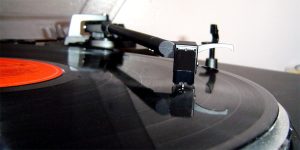In today’s digital age, there’s an unexpected revival of the nostalgic vinyl record, captivating the hearts of both old and young music enthusiasts. Amidst the sea of streaming and playlists, many find themselves asking, “how long is an LP?” and “How many songs can it truly hold?” Join us as we delve into the intricate world of vinyl, unraveling their timeless charm and answering these pressing questions. So, dear reader, dust off your old turntable and let’s embark on this melodious journey together.
Vinyl records and their anatomy

Vinyl records are not just carriers of beautiful sound; they’re also meticulously crafted objects with a rich history. Many wonder, “How much music can a vinyl hold?” To fully grasp this, it’s important to get acquainted with its anatomy and understand how many songs can fit on one.
- Grooves: These are the spiral-like patterns etched onto the surface of the vinyl. Each groove carries the recorded sound. The width and depth of the grooves determine the quality of the sound and the amount of music a record can hold.
- Sides: A standard vinyl record has two sides, side A and side B. Each side can contain a specific number of tracks, determined by the record’s size and speed.
- Labels: Positioned at the center of the vinyl, these labels provide essential information, such as the album name, artist, tracklist, and more.
The relationship between the groove size, speed, and recording time is intricate. Generally, wider grooves give better sound quality but take up more space, reducing the record’s total playtime.
Now, let me explain the most common types of vinyl records:
- Long play (LP):
- Speed: 33⅓ rpm
- Capacity: Typically up to 22 minutes per side for a total of around 44 minutes.
- Singles (45 rpm):
- Speed: 45 rpm
- Capacity: Generally up to 4-5 minutes per side.
- 78rpm records:
- Speed: 78 rpm
- Capacity: These records, which predate LPs and 45s, generally hold between 3 and 5 minutes of music per side. They’re made of shellac rather than vinyl, making them more brittle and prone to breakage.
Many ask “how long can a vinyl record be?” and delving into these details provides the clarity needed to answer that question.
Factors influencing recording capacity

Vinyl records are as much about art as they are about science. The amount of music one can hold isn’t just a simple question of size. Several factors dictate both the recording capacity and the quality of the sound:
Groove size and spacing:
Size: Wider grooves allow for better sound fidelity, especially for louder recordings or those with significant bass. However, they take up more space, reducing the total playtime.
Spacing: Closer spaced grooves mean more songs can fit on one side but might compromise sound quality if they’re too close.
Record diameter:
12 inches: Commonly used for LPs, offering a balance between playtime and sound quality.
7 inches: Mostly used for singles, limiting the number of songs due to its smaller size.
Rotation speed:
33⅓ rpm (LP): Slower speed, allowing for more recording time but may have slightly lower sound fidelity compared to faster speeds.
45 rpm (Single): Faster speed, resulting in better sound quality but reduced playtime.
In essence, the balance between groove size, record diameter, and rotation speed directly answers the question “how many songs can fit on a vinyl?”.
How many songs fit on a vinyl record overall?

The number of songs that can be accommodated on a vinyl record is influenced by a medley of factors, such as the size of the record (e.g., 7, 10, or 12 inches), the rotation speed (rpm), and the duration of the songs. Here’s a general guide:
7-inch single at 45 rpm:
Capacity: A typical 7-inch vinyl single at 45 rpm can host one song on each side.
Duration: Depending on factors like groove spacing and mastering choices, each side can usually accommodate between 2 to 4 minutes of music.
Total tracks: Thus, a 7-inch single typically contains 2 to 4 songs in total.
12-inch LP at 33⅓ rpm (Long Play):
Capacity: A standard 12-inch LP at 33⅓ rpm can hold more music than a single.
Duration: On average, such a record can include 22 to 24 minutes of music on each side.
Total tracks: This allows for the creation of longer albums, with the number of songs varying significantly. Typically, an LP contains between 8 to 12 songs, though this can fluctuate based on song lengths and desired sound quality.
12-inch Single at 45 rpm:
Capacity: Some 12-inch records are pressed at 45 rpm, often being singles.
Duration: They can house longer tracks than 7-inch singles. Each side of a 12-inch single spinning at 45 rpm can feature 6 to 8 minutes of music.
Total tracks: This makes them suitable for extended remixes or a collection of several tracks.














